
The K130 Braunschweig class is Germany's newest class of ocean-going corvettes. Five ships have replaced the Gepard-class fast attack craft of the German Navy.
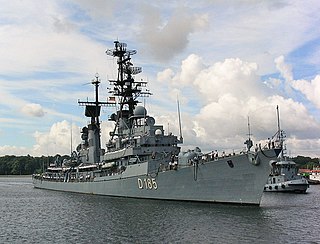
The Type 103 Lütjens class was the last class of destroyers in service with the German Navy. The ships were US Charles F. Adams-class guided missile destroyers but with some modifications to meet German requirements.
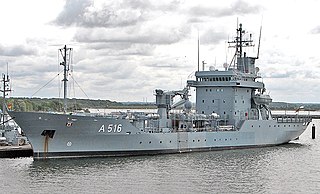
The Type 404 Elbe-class replenishment ships of the German Navy were built to support its squadrons of Fast Attack Craft, submarines and minesweeper/hunters, as such they are usually referred to as tenders.
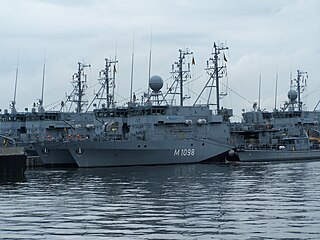
Type 352 Ensdorf-class minesweepers are a class of five minesweepers of the German Navy. They are Type 343 Hameln-class minesweepers that have been upgraded with the Troika Plus system of minesweeping drones
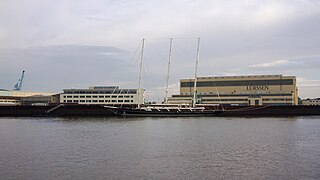
Lürssen is a German shipyard with headquarters in Bremen-Vegesack and shipbuilding facilities in Lemwerder, Berne and Bremen-Fähr-Lobbendorf.

Deutschland (A59) was a naval ship of the Bundesmarine, the West German Navy. She was constructed and used as a training cruiser ("Schulschiff") in peacetime and planned for multi-role missions in the event of war: troop ship, hospital ship, minelayer, and escort. In order to prepare cadets in the best possible way for their duties in the active fleet, the ship was carrying the type of armament and machinery that was reflecting the equipment fitted to the German Navy ships of that period. Therefore, the machinery was rather diverse, and performance-wise the emphasis had rather been laid on range than speed. Under deck, comparably large teaching rooms underlined the primary role and, unlike other ships in the fleet, Deutschland had some civilians serving alongside military personnel.

The Belgian Navy, officially the Naval Component of the Belgian Armed Forces, is the naval service of Belgium.

Type 320 Lindau-class minehunters was a class of German coastal minehunters built as part of the first FRG naval program. The ships were made from non-metallic components and built by Burmester Bremen. None of these ships now remain in service with the German Navy. Several went into service with the Estonian and Lithuanian Navy, as well as the Latvian Naval Forces. Flensburg and Weilheim became museum pieces.
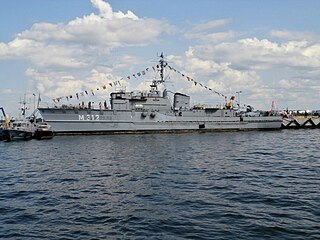
EML Sulev (M312) was a Lindau-class minehunter of the Estonian Navy Mineships Division.

EML Wambola (M311) is a Lindau-class minehunter of the Estonian Navy Mineships Division, formerly the German warship Cuxhaven. The commanding officer of the vessel is Captain Jaanus Antson. The minehunter Wambola is the first vessel of the Estonian Navy Mineships Division and also the first modernized Lindau-class minehunter. A black keel on a silver background with a golden battle-axe is on the coat of arms of the vessel. The battle-axe is a weapon used by the ancient Estonians which also symbolizes their fighting spirit and strength. The ships motto is the Latin "Ad unquem" which is in English "Onto the nail head". The coat of arms was designed by Priit Herodes. In 2000 a cooperation contract was signed between the Pärnu city council and the minehunter Wambola which gave the vessel a right to wear the Pärnu town coat of arms and to introduce the city in all foreign harbors across the world.
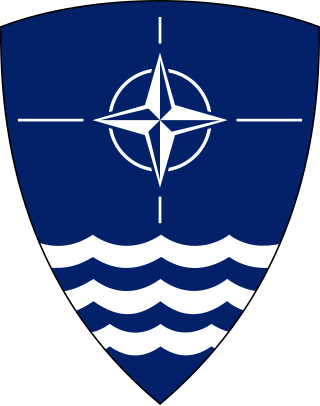
Allied Forces Baltic Approaches (BALTAP) was a Principal Subordinate Command (PSC) of the NATO Military Command Structure, with responsibility for the Baltic Sea area. It was in existence from 1962 to 2002 and consisted of the Danish Armed Forces, units of the West German Bundeswehr and allied wartime reinforcements.

Johann Günther Lütjens was a German admiral whose military service spanned more than 30 years and two world wars. Lütjens is best known for his actions during World War II and his command of the battleship Bismarck during her foray into the Atlantic Ocean in 1941.

Operation Sophia, formally European Union Naval Force Mediterranean, was a military operation of the European Union that was established as a consequence of the April 2015 Libya migrant shipwrecks with the aim of neutralising established refugee smuggling routes in the Mediterranean. The operational headquarters was located in Rome. The EU mandate for the operation ended on March 31, 2020. Operation Irini is the successor operation.
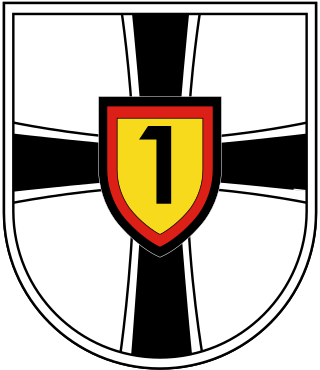
Einsatzflottille 1 is one of the three brigade-level units of the German Navy, in addition to Einsatzflottille 2 and the Naval Air Command. It is based in Kiel, Schleswig-Holstein, and is under the head of the Navy Command, based in Rostock.
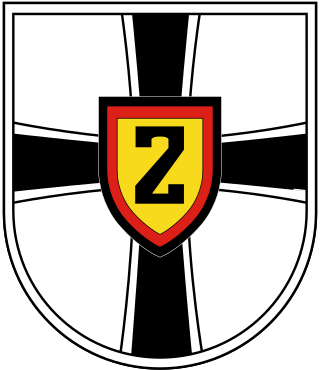
Einsatzflottille 2 is one of the three brigade-level units of the German Navy, in addition to Einsatzflottille 1 and the Naval Air Command. It is based in Wilhelmshaven, Lower Saxony, and is subordinated to Navy Command, based in Rostock.

The Type 401 Rhein-class tender was a class of tender ships which was laid down in 1958, christened in 1959 and put into service in 1961 and served as a support unit for the 3rd Schnellboot Squadron until they were decommissioned by 1992. A total of eight ships of this class were built, in addition to the ships Rhine, the Elbe, Main, Neckar, Ruhr, Weser, Werra and Danube.
















